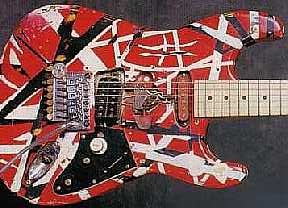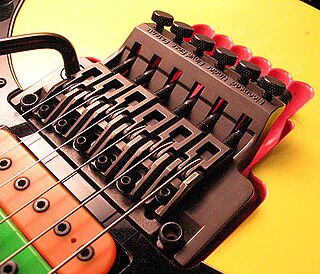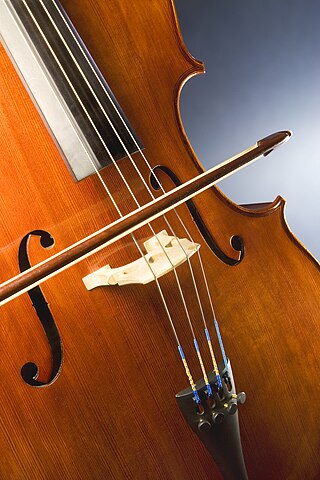
An electric guitar is a guitar that requires external amplification in order to be heard at typical performance volumes, unlike a standard acoustic guitar. It uses one or more pickups to convert the vibration of its strings into electrical signals, which ultimately are reproduced as sound by loudspeakers. The sound is sometimes shaped or electronically altered to achieve different timbres or tonal qualities from that of an acoustic guitar via amplifier settings or knobs on the guitar. Often, this is done through the use of effects such as reverb, distortion and "overdrive"; the latter is considered to be a key element of electric blues guitar music and jazz, rock and heavy-metal guitar-playing. Designs also exist combining attributes of the electric and acoustic guitars: the semi-acoustic and acoustic-electric guitars.

The Fender Showmaster is a discontinued model of electric guitar made by Fender, and is characteristic of a superstrat. Also see the badge change of Stagemaster due to legal reasons.

A machine head is a geared apparatus for tuning stringed musical instruments by adjusting string tension. Machine heads are used on mandolins, guitars, double basses and others, and are usually located on the instrument's headstock. Other names for guitar tuners include pegs, gears, machines, cranks, knobs, tensioners and tighteners.
A vibrato system on a guitar is a mechanical device used to temporarily change the pitch of the strings. It adds vibrato to the sound by changing the tension of the strings, typically at the bridge or tailpiece of an electric guitar using a controlling lever, which is alternately referred to as a whammy bar, vibrato bar, or tremolo arm. The lever enables the player to quickly and temporarily vary the tension and sometimes length of the strings, changing the pitch to create a vibrato, portamento, or pitch bend effect. Instruments without a vibrato have other bridge and tailpiece systems.

Floyd Rose SpeedLoader is a floating guitar bridge based on the Floyd Rose Original. In development since 1991, it was introduced to the public in 2003. This tremolo was developed in San Diego CA at AJ manufacturing by tool makers Jerry Morhman, Richard J Price, Steve Lamms, and Kerry L Stottlemyer under the direct guidance of Floyd Rose himself. With Richard J Price doing the majority of the design work and machining of the prototypes. Over 3000 hours and $150,000 were spent in developing this new ground breaking tremolo system and the first working unit on a guitar body. It inherited the locking floating bridge principle from the original version, but improved usability and diminished most of disadvantages that the Floyd Rose Original was criticized for, while adding the inconvenience of needing special-purpose strings. The Floyd Rose SpeedLoader is available in Tremolo, Fixed Bridge, and Convergent Tuning forms. However, the issues with strings became more apparent, as the specially made strings for the Speedloader were discontinued due to quality control issues. With no strings currently being manufactured, there is no way to properly string and set up any guitar with the Floyd Rose Speedloader. Customers have voiced their discontent with Floyd Rose for a lack of development of any parts that could remedy the situation.
The Jackson Soloist is an electric guitar model introduced by Jackson Guitars in 1984, although prototypes were available before then. The design is a typical "superstrat"; it varies from a typical Stratocaster because of its neck-thru design; tremolo: Floyd Rose or similar, Kahler; or a fixed Tune-O-Matic; premium woods; a deeper cutaway at the lower horn for better access to the higher frets, and a sharper body with squared-off edges.
A nut, on a stringed musical instrument, is a small piece of hard material that supports the strings at the end closest to the headstock or scroll. The nut marks one end of the vibrating length of each open string, sets the spacing of the strings across the neck, and usually holds the strings at the proper height from the fingerboard. Along with the bridge, the nut defines the scale lengths of the open strings.

The Kahler Tremolo System is an electric guitar bridge with a cam operated vibrato arm system. The original flat mount and stud mount models were invented and patented by Dave Storey and licensed to Gary Kahler. Gary Kahler shifted his business model to making Golf clubs in the 1990s, but went back to bridge manufacturing as of April 2005. Dave Storey went on to invent, patent, and manufacture his line of Dava guitar picks.

Schaller GmbH is a German manufacturer of musical instrument hardware, based in Postbauer-Heng near Nuremberg, Bavaria, which designs and produces guitar tuners, bridges, tremolos, strap locks and other guitar accessories. The company has been owned by Dr Lars Bünning since 2009.

Kramer Guitars is an American manufacturer of electric guitars and basses. Kramer produced aluminum-necked electric guitars and basses in the 1970s and wooden-necked guitars catering to hard rock and heavy metal musicians in the 1980s; Kramer is currently a division of Gibson Guitar Corporation.

The Frankenstrat, also known as "Frankie", is a guitar created by Eddie Van Halen. Its name is a portmanteau of Frankenstein, the fictional doctor who created a monster by combining body parts of the recently deceased, and the Stratocaster, a model of electric guitar made by Fender.

Fender Contemporary Stratocaster electric guitars were produced by Fender Japan in the 1980s.

The Ibanez Edge Tremolo is a double locking tremolo system for the electric guitar very similar in design to the original Floyd Rose. It first appeared in the Ibanez product line as of the 1986 model year; however, they have appeared on guitars with 1985 serial numbers. The Edge offers a number of improvements from the Original Floyd Rose, namely locking studs, a spring retainer on the tremolo block and a pop-in arm.
The Fender Prodigy is a discontinued model of electric guitar produced by Fender from 1991 to 1993. It is one of Fender's attempts to compete with the superstrat-style guitars produced by Ibanez, Jackson/Charvel, Carvin Corporation and Yamaha. Since the Prodigy series was discontinued after about 2+1⁄2 years of production without a clear reason, it is considered one of Fender's rare models because of its limited production. Fender also produced a Prodigy Bass based on the Precision Bass Plus Deluxe featuring a P/J pickup layout (P as in Fender Precision Bass and J as in Fender Jazz Bass), 2-band active circuitry and a "fine-tuner" Schaller Elite bridge assembly.
The Fender American Deluxe Series was a line of electric guitars and basses introduced by Fender in 1995 and discontinued in 2016. It was upgraded in 2004 and 2010 before being replaced by the American Elite series in 2016.

The Ibanez ZR Tremolo is a double locking tremolo system developed by Ibanez. The ball-bearing and global tuner features of the ZR tremolos are manufactured under license to American Inventor and recording artist, Geoffrey Lee McCabe—see U.S. Patent Nos. 6,175,066 5,965,831, 6,891,094, 5,986,191, 6,563,034 and 7,470,841.

A bridge is a device that supports the strings on a stringed musical instrument and transmits the vibration of those strings to another structural component of the instrument—typically a soundboard, such as the top of a guitar or violin—which transfers the sound to the surrounding air. Depending on the instrument, the bridge may be made of carved wood, metal or other materials. The bridge supports the strings and holds them over the body of the instrument under tension.

The Peavey EVH Wolfgang guitar series is a collaboration between guitarist Eddie Van Halen and Hartley Peavey's company, Peavey Electronics. The EVH stands for "Eddie Van Halen" while Wolfgang is the name of Eddie Van Halen's son.
The Yamaha Corporation is a multinational corporation and conglomerate based in Japan with a wide range of products and services, predominantly musical instruments, motorcycles, power sports equipment and electronics.
Blade Guitars is a manufacturer of electric guitars and bass guitars founded by luthier Gary Levinson in 1987. Levinson had been repairing guitars since 1964 and, in 1977, during his graduate studies at the University of Basel, Switzerland, he founded Guitars by Levinson. Using the experience he gathered from his work, he decided to start Blade Guitars in 1985. By 1986, he was refining the idea of a line of guitars based on the concept he defines as "Classic Design, Creative Technology"; at this time, he was also determining the features that would characterize his range of guitars. In January 1987, a manufacturing deal was reached for the production of the guitars. Blade Guitars made their debut in October 1987, at the music show of Tokyo. Their presentation at the Frankfurt Musikmesse in 1988 signalled their European launch.



















